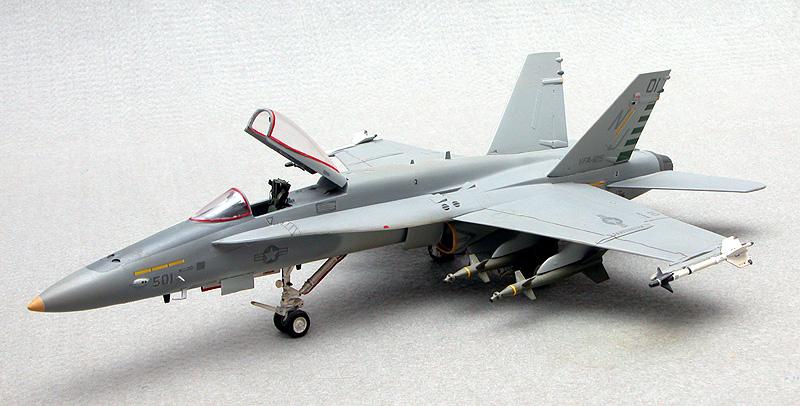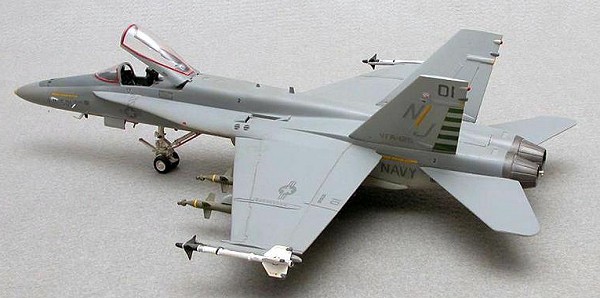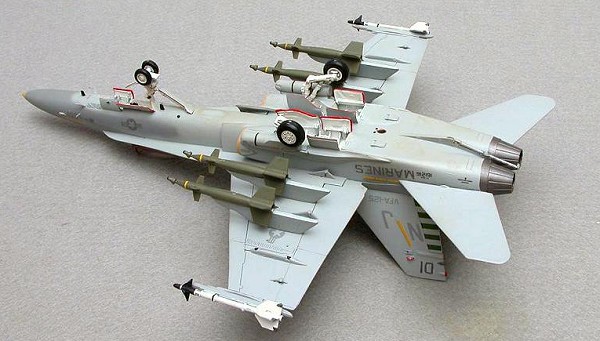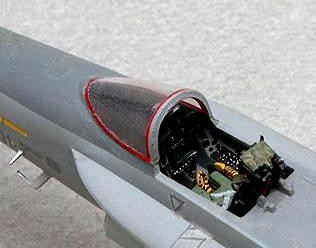
| KIT #: | 5833 |
| PRICE: | $12.00 MSRP in 1987 |
| DECALS: | One option |
| REVIEWER: | Richard Hammond |
| NOTES: | Built out of the box |

| HISTORY |
The
F/A-18 Hornet is a modern jet fighter built by McDonnell Aircraft Company.
The F/A-18 is based upon the experimental YF-17 designed and built by
Northrop Corporation during the 1970's under contract with the U.S. Air
Force. In a tight competition, General Dynamics' F-16 Falcon was ultimately
chosen as the Air Force's mainstay fighter. Later, in an effort to
 salvage
their efforts, Northrop teamed up with McDonnell Douglas to produce a new
naval air combat fighter known as VFAX. McDonnell Douglas' experience was
useful because of their extensive background in carrier-based fighter
design. For this reason, McDonnell Douglas became the primary contractor
with Northrop being the major subcontractor. Although the original idea was
to design an F-18 fighter version and an A-18 attack version, it was
decided to build a multi-role F/A-18 because the differences between the
two versions were so minor.
salvage
their efforts, Northrop teamed up with McDonnell Douglas to produce a new
naval air combat fighter known as VFAX. McDonnell Douglas' experience was
useful because of their extensive background in carrier-based fighter
design. For this reason, McDonnell Douglas became the primary contractor
with Northrop being the major subcontractor. Although the original idea was
to design an F-18 fighter version and an A-18 attack version, it was
decided to build a multi-role F/A-18 because the differences between the
two versions were so minor.
The McDonnell Douglas F-18 flew for the first time on November 18th, 1987.
The F/A-18 is a larger and broader version of the YF-17 adding greatly
improved performance. Two GE F404 engines producing 16,000lbs of thrust
each making the airplane’s maximum velocity Mach 1.8 power the F/A-18.
The original F/A-18A (single seat) and F/A-18B (dual seat) became
operational in 1983 replacing Navy and Marine Corps F-4s and A-7s. It
quickly became the battle group commander's mainstay because of its
capability, versatility and availability. Reliability and ease of
maintenance were emphasized in its design, and F/A-18s have consistently
flown three times more hours without failure than other Navy tactical
aircraft, while requiring half the maintenance time.
The
F/A-18 has a digital control-by-wire flight control system, which provides
excellent handling qualities, and allows pilots to learn to fly the
airplane with relative ease. At the same time, this system provides
exceptional maneuverability and allows the pilot to concentrate on
operating the weapons system. A solid thrust-to-weight ratio and superior
turn characteristics combined with energy sustainability, enable the F/A-18
to hold its own against any adversary. The power to maintain evasive action
is what many pilots consider the Hornet's finest trait. In addition, the
F/A-18 was also the Navy's first tactical jet aircraft to incorporate a
digital, MUX bus architecture for the entire system's avionics suite. The
benefit of this design
feature is that the F/A-18 has been relatively easy to upgrade on a
regular, affordable basis.
this design
feature is that the F/A-18 has been relatively easy to upgrade on a
regular, affordable basis.
Following a successful run of more than 400 A and B models, the U.S. Navy began taking fleet deliveries of improved F/A-18C (single seat) and F/A-18D (dual seat) models in September 1987. These Hornets carry the Advanced Medium Range Air-to-Air Missile (AMRAAM) and the infrared imaging Maverick air-to-ground missile. Two years later, the C/D models came with improved night attack capabilities. The new components included a navigation forward looking infrared (NAVFLIR) pod, a raster head-up display, night vision goggles, special cockpit lighting compatible with the night vision devices, a digital color moving map and an independent multipurpose color display.
F/A-18Cs have synthetic aperture ground mapping radar with a Doppler beam-sharpening mode to generate ground maps. This ground mapping capability that permits crews to locate and attack targets in adverse weather and poor visibility or to precisely update the aircraft's location relative to targets during the approach, a capability that improves bombing accuracy. New production F/A-18Cs received the APG-73 radar upgrade radars starting in 1994, providing more precise and clear radar displays.
| THE KIT |
The Monogram kit, though dated, is still a great kit. It has over 90 pieces of gray styrene, sharply molded and free of flash. Detail is excellent, but the kit has raised panel lines, a testament to it’s age. The cockpit is very well represented. Decals were sharply registered. The wheel wells are molded into the fuselage but are well detailed. Landing gear accurately depicts the complex nature of the Hornet’s landing gear. The canopy is inaccurate in shape, however. Due to the molding process, it has straight sides instead of “blown sides”. All in all, though, it is a great kit and the price is considerably less than that of the Hasegawa kit. It comes with laser guided bombs and Sidewinder missiles. A laser designator and FLIR pod also comes with the kit. There is an optional position canopy and speed brake. I chose to leave the canopy open and the speed brake closed. The exhaust “turkey feathers” are a little simplified.
| CONSTRUCTION |
 I had
taken a long layoff from modeling and decided to get back into it about a
year ago. I had this kit in the closet for a while and grabbed it, thinking
it would be a good way to get back into the hobby. This kit was built
straight from the box, and I used the kit decals. The kit goes together
well, with good fit. I did have to fill some seams where the top and bottom
halves of the fuselage came together, but for the most part it went
together easily. The cockpit is very well detailed given the age of the
kit. The seat is well represented by 4 pieces and the side consoles have
excellent raised detail. It also comes with a separate throttle quadrant.
The instrument panel has excellent raised and recessed detail. The
instructions even tell you where to add paper to simulate the risers. For
the time that this kit came out, that was ahead of it’s time!
I had
taken a long layoff from modeling and decided to get back into it about a
year ago. I had this kit in the closet for a while and grabbed it, thinking
it would be a good way to get back into the hobby. This kit was built
straight from the box, and I used the kit decals. The kit goes together
well, with good fit. I did have to fill some seams where the top and bottom
halves of the fuselage came together, but for the most part it went
together easily. The cockpit is very well detailed given the age of the
kit. The seat is well represented by 4 pieces and the side consoles have
excellent raised detail. It also comes with a separate throttle quadrant.
The instrument panel has excellent raised and recessed detail. The
instructions even tell you where to add paper to simulate the risers. For
the time that this kit came out, that was ahead of it’s time!
Construction was according to the instructions and I did not have any major problems.
| COLORS & MARKINGS |
I used Model Master light and dark Ghost Gray for the camouflage. Flat white was used to paint the wheel wells. I airbrushed the gray first and then masked around the wheel wells and painted them white. When the paint was dry I gave it several coats of “Future” and set it aside to cure. I applied the decals from the kit, applied a second coat of Future over them to seal them and then masked the wheel wells with some tissue paper. I then airbrushed Dullcote over it. I masked the wheel wells since they should have a gloss finish.
When all was dry, I added the ordnance and pods. I chose not to do anything with the raised panel lines.
| CONCLUSIONS |
This was a fun kit to build and one to get back into the hobby with. It is not a state of the art kit and there is a “high tech” version out that has updated decals and some photo etch. But when it is finished, it looks like a Hornet and it is a good bit less expensive than the newer more detailed Hornets from Hasegawa and Academy.
A very special thanks to Tom Cleaver for all his modeling and photography advice. Thanks Tom!
November 2004
Copyright ModelingMadness.com. All rights reserved. No reproduction in part or in whole without express permission.
If you would like your product reviewed fairly and fairly quickly, please contact the editor or see other details in the Note to Contributors.